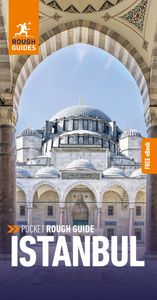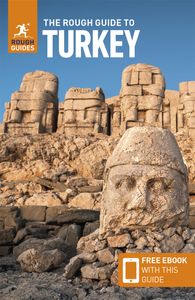Haydarpaşa
South of Üsküdar and across the bay from Kadıköy, the serried ranks of enormous nineteenth- and early twentieth-century buildings in Haydarpaşa make quite an impact as you approach by ferry. The palace-like mainline Haydarpaşa train station, jutting into the Bosphorus, was completed in 1908 by a German architect as part of Germany’s grandiose plans for a Berlin-to-Baghdad railway. It was presented to Sultan Abdülhamid II by Kaiser Wilhelm II; its stained glass is particularly impressive. The station is likely to be sidelined by the giant Marmaray transport infrastructure project, and was only open for suburban services at the time of writing.
Directly north of the station, between the sea and Tıbbiye Caddesiare, is the Marmara University and the British War Cemetery, a beautifully kept spot sheltering the dead of the Crimean War and the two world wars.
Kadıköy
The suburb of Kadıköy makes for a surprisingly enjoyable outing from the European side of the city. It’s a lively place, with some great shops, restaurants, bars and cinemas. One of the area’s charms is its local feel – which is hardly surprising, as unlike in Sultanahmet or Beyoulu, most of the people out and about here are residents. Towards the end of the nineteenth century, when the introduction of steam-driven ferries made it feasible to commute across the Bosphorus, Kadıköy became a popular residential area for foreign businesspeople and wealthy Greeks and Armenians. Their most visible legacy is the churches southeast of the ferry terminal. There’s a scattering of older constructions amid the concrete: look out for the tall, narrow curves of the cream Art Deco-style Kuru Kahveci Mehmet Efendi building, home to the famous purveyor of Turkish Coffee, and the beautifully restored Süreyya Opera House on Bahariye Caddesi (see p.130); dating back to 1927, its ornate Neoclassical facade is adorned with relief-work pilasters, cherubs and classical-style theatre masks.
Most sites of interest in Kadıköy are located between the waterfront Sahil Yolu (coast road) and Bahariye Caddesi, a right turn off Söğütlüceşme Caddesi, the steep, wide street that leads uphill from the ferry terminal. The two latter streets have their own tram, a grittier version of İstiklal Caddesi; indeed, the area bounded by Söğütlüceşme Caddesi to the north, Bahariye and Emın Bey caddesis to the east and south and the Bosphorus waterfront to the west is becoming a mini-Beyoğlu, with a similar mix of alternative-clothing outlets, bookstores and bric-a-brac shops dotted among the cafés and restaurants that spill out onto jam-packed pedestrianized streets. It’s also a great area for shopping, especially for spices, coffee, olives, dried fruit, nuts, Turkish delight and other goodies, in the colourful permanent market centred on Guneşlibahçe Sokak.
Kız Kulesi
South of Üsküdar, on an island in the Bosphorus, the small white Kız Kulesi (Maiden’s Tower) is also known as Leander’s Tower. Many myths are associated with it: in one a princess, who was prophesied to die from a snake bite, came here to escape her fate, only to succumb to it when a serpent was delivered to her retreat in a basket of fruit. The tower also featured in the 1999 James Bond film, The World Is Not Enough. Now open to visitors, it doubles as an expensive restaurant in the evening.
Üsküdar
Üsküdar holds some notable Islamic monuments. Its most obvious mosque, İskele or Mihrimah Camii, sits on a high platform, fronted by an immense covered porch, opposite the ferry landing on İskele Meydanı. Designed by Mimar Sinan and built in 1547–48, it’s the only Ottoman mosque with three semi-domes (as opposed to two or four), thanks to the requirements of a difficult site against the hillside behind.
Directly across the square, the Yeni Valide Camii was built between 1708 and 1710 by Ahmet III in honour of his mother. It’s most readily identified by the Valide Sultan’s green, birdcage-like tomb, whose meshed roof was designed to keep birds out while allowing rain in to water the garden tomb below.























